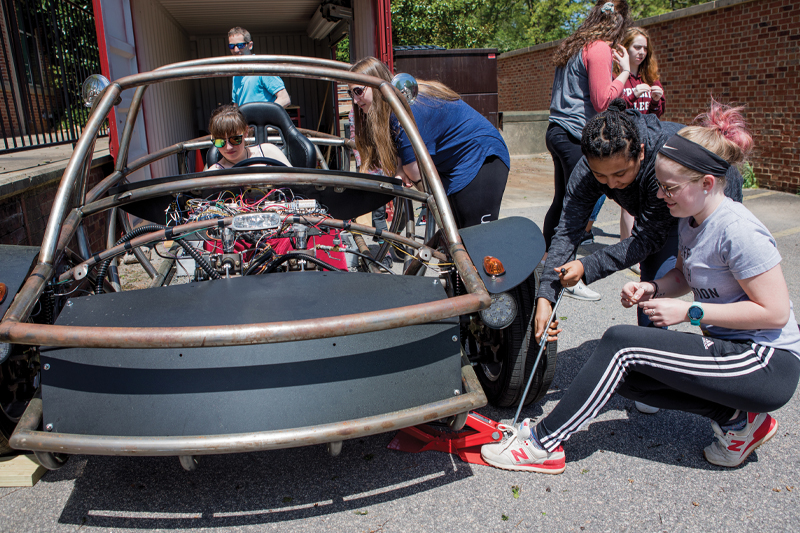Batteries Required
- By Gaye Hill
- Published

Today’s engineering students are often challenged by a lack of hands-on experience prior to coming to college that once was acquired by working on cars and other projects around the home – a knowledge gap that can be more pronounced among women.
Meredith helps first-year engineering students “learn by doing” through a class that revolves around a stripped-down electric car designed for educational purposes. Working in teams on a variety of projects, students acquire practical knowledge and essential problem-solving skills that prepare them to succeed as they move into more challenging courses.
“Because of the e-car’s simplicity, students can do simple modifications that are central to the whole car. They begin to understand the constraints of design, and why things are built the way they are. Developing a stronger understanding of how cars work helps them make connections between academic ideas and real-world application of those ideas.”
– Bill Schmidt, Professor of Physics
E-Car Quick Facts
Motor
Some learning results from simple observation. For example, when students are asked how to loosen the e-car’s motor, they are prompted to examine the mounts on the motor, which leads them to figure out what kind of leverage and wrenches they’ll need to make it happen.
Batteries
The 72-V battery pack in the front, along with the DC controller and electric motor in the rear, make up the e-car’s propulsion system. Students are asked to trace the wires that run throughout the car and explain where they go, what they do, and why they’re needed.
Battery Charger
Students are asked to write a “story of propulsion,” explaining how electrons in the batteries are able to provide kinetic energy of propulsion for the car.
Tire
Doing simple repairs such as changing a tire, adding brake fluid, adjusting steering, and bleeding brake lines builds students’ confidence in using tools and has the added benefit of teaching them practical life skills.
“Working on the electric car with Dr. Schmidt was an excellent example of the engineering design process at work. I enjoyed being able to work with my Meredith classmates to overcome technical challenges, identify new ideas, and apply new solutions. Our electric car team was able to identify mechanical and electrical issues and apply our individual skills to solve problems.”
– Laura Potok, ’22
Established over a decade ago, Meredith’s dual degree engineering program allows students to combine a well-rounded liberal arts education at a women’s college with one of the most respected engineering programs in the country through a partnership with NC State University. Students simultaneously complete the academic requirements of both institutions. Upon graduation from the five year program, students earn two degrees – one from each institution. New options recently added include computer, biomedical, and textile engineering.
News Director
316 Johnson Hall
(919) 760-8087
Fax: (919) 760-8330
PRINCETON REVIEW
U.S. NEWS
NICHE
PRINCETON REVIEW
U.S. NEWS
NICHE
3800 Hillsborough Street Raleigh, NC 27607-5298 | (919) 760-8600 Fax: (919) 760-8330 | © 2024 All Rights Reserved.